VI.
PLANT COMMUNITIES
C. COASTAL LIVE OAK WOODLANDS
Coastal
live oak woodlands occur in the more mesic areas of
coastal California from Sonoma County south into Baja
California. The term "woodland" is used instead of
"forest" because woodlands tend to be more open and
sunlit, their canopies sometimes touching, but rarely
overlapping. Woodlands are typically found below 5000
feet in soils too dry to support a forest. They are
found within a 50-mile radius of the coast, out of
the influence of salt spray. Fog is common in these
areas. Soils are typically well drained. Although
certainly not limited to these areas, coastal live
oak woodlands are quite common in the ravines and
moister drainages between grassy hillsides, as is
the case in Poly Canyon. These woodlands are also
common on north-facing slopes.
The
dominant plant is coast live oak (Quercus agrifolia),
which often is found in monotypic (pure) stands. Twenty-million-year-old
fossils of coast live oak found in the Pacific Northwest
reveal that there has been little change in the species
over time. The coast live oak has several features
that enable it to survive the hot dry summers of the
Mediterranean climate where it is found. It has a
specialized root system including a deep tap root
and tiered feeder roots which collect moisture at
several levels in the soil. Also, its xylem tissues
(the ones dedicated to the transport of water from
the roots to the leaves) tend to harden as the summer
drought progresses. Its evergreen, sclerophyllous
leaves have a thick waxy cuticle which, in conjunction
with stomata (pores) that close in response to seasonal
midday aridity, keeps water losses at a minimum. Other
characteristics suggestive of hot summer and/or summer
drought adaptedness are the leaves found on different
parts of the tree. Variation in leaf size and shape
is common among oaks, the coast live oak being no
exception. However, with all this, two main types
of leaves have been identified. The outermost leaves
are thick, small, and convex with two to three layers
of photosynthetic cells. These characteristics make
them good at releasing excess heat, collecting light,
and also manufacturing food. Leaves found beneath
these toward the middle or basal parts of the tree
tend to be thinner, wider, and flatter with only one
layer of photosynthetic cells. These leaves are protected
from the most intense heat by being in the shade of
the outermost leaves, yet they are still able to photosynthesize.
This sort of shade-adapted leaves is also found on
seedlings growing in low-light.
An
intrinsic part of coastal live oak woodland ecology
is fire. Coast live oaks have a thick bark that insulates
inner tissues from relatively low-intensity (modest
heat over a short time), infrequent fires. A higher-intensity
fire can be survived by crown-sprouting, when the
above-ground portion of the tree is killed, but the
buried root crown resprouts. In some cases, sprouts
can also be seen originating from the trunk. Buried
acorns may also sprout after a fire. There are certain
adaptive advantages to fire in this community: other
plant species that compete with oak seedlings and
saplings for water and nutrients are eliminated; more
mineral nutrients become available as rains leach
them from burned wood and ashes; and debilitating
insect pests are temporarily eliminated from the foliage,
bark, and buds. As with most factors affecting growth
and development, even with fire there is an ideal
frequency range which promotes health in the community.
If fire is suppressed too long, non-native species
overrun the understory, killing oak seedlings and
saplings that are not well established. However, if
fires occur too frequently, seedlings and saplings
are killed off and viable acorns are eliminated from
the area, stalling for many years a healthy regeneration
of the woodland.
In
mesic stands, where moisture is available, typical
understory species include California blackberry (Rubus
ursinus), creeping snowberry (Symphoricarpos
mollis), toyon (Heteromeles arbutifolia),
and western poison oak (Toxicodendron diversilobum).
An herbaceous layer would include bracken fern (Pteridium
aquilinum), California polypody (Polypodium
californicum), and miner's lettuce (Claytonia
perfoliata).
In
drier areas, where the oak canopy is not as dense,
the coastal live oak woodland forms an ecotone with
one of several adjacent communities. Where it intergrades
with a grassland, its understory has a higher component
of grasses than shrubs. On steeper slopes, there are
usually more shrubs in the understory as the woodland
intergrades with chaparral - manzanita (Arctostaphylos
spp.), chamise (Adenostoma fasciculatum), fuchsia-flowered
gooseberry (Ribes speciosum), and California
lilac (Ceanothus spp.) - or with coastal scrub
- California sagebrush (Artemisia californica),
black sage (Salvia mellifera), coyote bush
(Baccharis pilularis), or sticky monkeyflower
(Mimulus aurantiacus). Western poison oak (Toxicodendron
diversilobum) is ubiquitous. In Poly Canyon there
are several woodland sites that border grassland communities.
Here a weedy non-native, Italian thistle (Carduus
pycnocephalus), forms a dense, monotypic cover
beneath the oaks. Controlled grazing of sheep under
holistic resource management regimes has been used
to repopulate similar areas with more desirable native
perennials. This is discussed further under the grasslands
section.
- In
Poly Canyon, the single dominant species in coastal
live oak woodlands is:
- *Coast
live oak, encina (Quercus agrifolia, Fagaceae)
- Associate
species include:
- *Toyon,
Christmas berry (Heteromeles arbutifolia,
Rosaceae)
- *California
bay, California laurel, pepperwood, bay-laurel (Umbellularia
californica, Lauraceae)
- Understory
species include:
- *California
sagebrush, coastal sagebrush (Artemisia californica,
Asteraceae)
- Aster
(Aster radulinus, Asteraceae)
- *Sticky
monkeyflower, bush monkeyflower (Mimulus aurantiacus,
Scrophulariaceae)
-
- Goldback
fern (Pentagramma triangularis, Pteridaceae)
- *California
coffeeberry (Rhamnus californica, Rhamnaceae)
- *California
blackberry (Rubus ursinus, Rosaceae)
- *Hummingbird
sage, pitcher sage (Salvia spathacea, Lamiaceae)
- *Blue
elderberry (Sambucus mexicana, Caprifoliaceae)
- Hedge-nettle
(Stachys bullata, Lamiaceae)
-
Creeping snowberry, trip vine (Symphoricarpos
mollis, Caprifoliaceae)
- *Western
poison oak (Toxicodendron diversilobum, Anacardiaceae)
Descriptions
of Poly Canyon's coastal live oak woodland plants
follow.
|
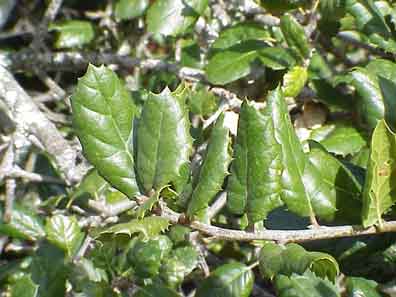
*Coast
live oak, encina (Quercus agrifolia,
Fagaceae) This is a 6- to 25-m. (20- to 82-foot)
evergreen monoecious tree. It can be extremely
long-lived (usually more than 250 years, even
600). It has 21/2- to 6-cm. (1- to 21/2-inch)
leathery, spiny-toothed, ovate, dull green leaves.
The upper surface of the leaves is convex. The
lower surface often looks as if it has cobwebs
in the axils of its veins; actually, these are
tufts of tiny star-shaped hairs. The male inflorescence
is a catkin near the base of a twig, and the
female inflorescence is a single flower surrounded
by a cup of scale-like bracts. Blooms appear
from March through April. The 25- to 35-mm.
(1- to 11/2-inch) slender, pointed acorns mature
in one year. Coast live oaks also occur in valleys,
on grassy hillsides, and in riparian woodlands.
Quercus
is the ancient Latin name for oak. From this
name we derive "cork," a product of some species
of oak. In turn, Quercus comes from two
Celtic words: quer "fine" and quez
"tree." Agrifolia was a printer's error
for aquifolia, meaning "holly-leafed."
Encina
has been highly valued by Chumash, who have
used its wood for fuel, bowmaking, games, cooking
utensils, and cradles. They also used its bark
for a red dye for hides. They used its bark
and galls in medicine (tannins have astringent
properties). Its bellotas (acorns) have
been used as food for at least 5,000 years.
The acorns are dried, finely ground, and leached
of tannins, then cooked into an unseasoned mush.
In trade, five hatfuls of acorns was worth one
hatful of chia, and two hatfuls of acorns was
worth one of islay.
|
Associated
species include:
|
*Toyon, Christmas berry (Heteromeles
arbutifolia, Rosaceae)
click here for
description
|
|
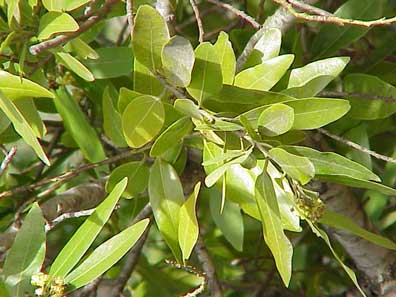
*California
bay, California laurel, pepperwood, bay-laurel
(Umbellularia californica, Lauraceae)
This is an aromatic evergreen shrub or tree
that grows to 45 m. (148 feet) tall. It has
3- to 10-cm. (11/2- to 4-inch) shiny, deep green
lanceolate leaves. Six to ten yellow-green 6-mm.
(1/4-inch) flowers bloom in umbels from December
through May. The 2-cm (3/4-inch) fruit, a drupe,
resembles an olive and ranges in color from
green to dark purple. Bay-laurel is also found
in canyons and valleys and in some chaparral
habitats.
Umbellula
is Latin for "small umbel." Californica
means "of California."
Laurel
is the Spanish name. Early Californians used
the burls of laurel to form bowls. They used
the wood in rituals. Tea from the leaves was
used by them to fight colds. The leaves were
mixed with lard as a cure for diarrhea. Rheumatism
was treated with laurel leaves in a hot bath.
Leaves have been used to flavor foods, as a
flea and witch repellant, and crushed leaves
sniffed to cure headaches. The fruit was eaten
raw or boiled; the kernel roasted and ground
for cake flour.
|
Understory
species:
|
*California sagebrush, coastal sagebrush
(Artemisia californica, Asteraceae)
click here
for description
|
|

Donald Myrick
Aster
(Aster radulinus, Asteraceae) This is
a 2- to 7-dm. (8- to 28-inch) perennial. It
spreads by rhizomes. Its 4- to 10-cm. (11/2-
to 4-inch) elliptic, pointed, serrate leaves
occur along a hairy stem. The inflorescence
is a flat-topped cyme or panicle. Showy white
to purplish ray florets bloom from July through
October. The fruit is a hairy achene. This aster
is found primarily in dry woods.
Aster
is Greek for "star." Radulinus means
"scraper."
|
|
*Sticky monkeyflower, bush monkeyflower
(Mimulus aurantiacus, Scrophulariaceae)
click here
for description
|
|
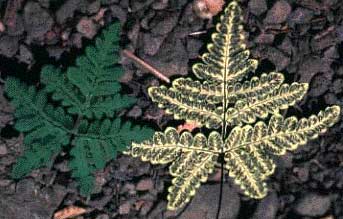
*Goldback
fern (Pentagramma triangularis, Pteridaceae)
This plant has 3- to 18-cm. (11/4- to 7-inch)
fronds that are somewhat triangular in shape.
The fronds are twice to three times pinnately
lobed. There is a waxy, yellow exudate on the
lower surface of the fronds, hence the common
name "goldback fern." Sporangia occur along
the veins, rather than in sori. Goldback fern
is found primarily near rocks and boulders in
shaded areas.
Penta
is Greek for "five." Gramma means "letter"
or "writing."
|
|
*California coffeeberry (Rhamnus californica,
Rhamnaceae)
click
here for description
|
|

*California
blackberry (Rubus ursinus, Rosaceae)
This is an evergreen, prickly, mounding and/or
spreading shrub. It has prickly leaves measuring
between 4 and 15 cm. (11/2 and 6 inches). The
leaves are simple and palmately lobed or divided
into three leaflets. The 5- to 25-mm. (1/4-
to 1-inch) white flowers bloom from March through
June. Then 2-cm. (3/4-inch) aggregates of black
berry-like fruits (drupes) develop through the
summer. One might confuse blackberry with poison
oak. However, poison oak has no prickles on
its stems or leaves, and the flowers and fruits
look completely different. California blackberry
occurs in moist places in shrublands and at
streamsides.
Rubus
comes from Latin and means "bramble." Ursinus
means "bear."
Moras
or zarzamoras (zarza means
bramble) were eaten by early Californians unless
they were found growing in a damp place. The
root was boiled into tea with which to cure
diarrhea.
|
|
*Hummingbird sage, pitcher sage (Salvia
spathacea, Lamiaceae)
click here
for description
|
|
*Blue elderberry (Sambucus mexicana,
Caprifoliaceae)
click here
for description
|
|
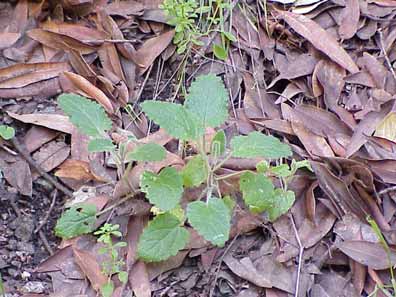
Hedge-nettle
(Stachys bullata, Lamiaceae) Hedge-nettle
is a 4- to 8-dm. (16- to 32-inch) perennial.
It has opposite, ovate, round-toothed, aromatic
3- to 18-cm. (11/4- to 7-inch) leaves that are
somewhat puckered and fuzzy. It has 5-cm.+ (2-inch+)
whorls of flowers around the stem. The flowers
are two-lipped. The corolla tube measures 7
to 10 mm. (1/4 to 1/2 inch). Petals are pink
to lavender-red, with white markings on the
lower lips. The flowers bloom from March through
May. The fruits, nutlets, are inconspicuous.
Hedge-nettle is common on dry slopes.
Stachys
means "spike," referring to the spikes of flowers.
Bullata means "puckered," referring to
the leaves.
|
|
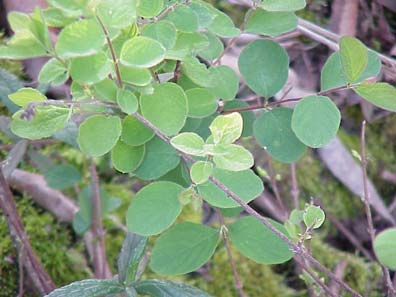
Creeping
snowberry, trip vine (Symphoricarpos
mollis, Caprifoliaceae) Creeping snowberry
is a low-growing, spreading deciduous shrub
with 11/2- to 6-dm. (6- to 24-inch) stems. It
has 1/2- to 3-cm. (1/4- to 11/4-inch) opposite,
thin, oval leaves. Its paired, hanging, bell-shaped,
pinkish-white flowers bloom from April through
June. Then, 8-mm. (1/3-inch) white berries develop,
usually in pairs, in the late summer and early
fall. Creeping snowberry is found along streamsides,
on ridges and slopes, and in open places in
woodland habitats.
Symphoricarpos
means "fruit born together." Mollis means
"soft, tender, flexible."
The
local Spanish names were oreja de ratón
("rat's ear," referring to the leaf shape) or
escoba (broom, referring to one of its uses).
Early Californians wove branches into baskets.
They also made toy arrows of the branches. The
fruit was eaten, primarily by children.
|
|
*Western poison oak (Toxicodendron diversilobum,
Anacardiaceae)
click here
for description
|
|